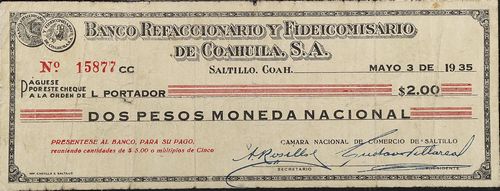The crisis of 1935
A small group of low-value notes bears testimony to a period in Mexico’s history when it was confronted by a shortage of coins and the consequent effect on daily business. The United States passed its American Silver Purchase Act on 19 June 1934: this caused to price of silver to increase and as a result, in Mexico, silver coins began to be hoarded to be remelted at a profit.
On 25 April 1935 the Mexican government reacted with a series of reforms, changing the fineness of its coinage, and withdrawing silver coins from circulation. It had ordered 50c coins (tostones) and $1 Banco de México notes from the United States but until these arrived the sudden shortage of small change led many commercial organisations, particularly Chambers of Commerce, to agree with the local banks to issue scrip in the form of bearer cheques (cheques al portador).
Though there were mutterings that these breached the legislation on paper currency, the Secretaría de Hacienda y Crédito Público was generally acquiescent. The cheques were of low denominations, backed by deposits in the banks, of voluntary (but general) acceptance and redeemable on demand (occasionally stated as in multiples of five pesos, the lowest value banknote).
When the crisis passed most of these cheques were redeemed (out of $10,000 issued by the Uníon Nacional de Industria y Comercio in Guadalajara only $18 was not handed in) and so survivors are extremely rare. Indeed, though the shortage was nationwide we have examples from just ten cities and mention of a few others. A few others will no doubt emerge over time but to expand our knowledge we should rely on newspapers and other such sources. Mexico had a vibrant local press at this time but access is patchy.
Saltillo
 M4267 $1 Banco Refaccionario y Fideicomisario de Coahuila
M4267 $1 Banco Refaccionario y Fideicomisario de Coahuila

 M4268 $2 Banco Refaccionario y Fideicomisario de Coahuila
M4268 $2 Banco Refaccionario y Fideicomisario de Coahuila
| from | to | total number |
total value |
||
| $1 | includes number 10839 | ||||
| $2 | includes number 15877 |
In Saltillo, on 3 May the Cámara Nacional de Comercio issued $1 and $2 cheques drawn on the Banco Refaccionario y Fideicomisario de CoahuilaThe Banco Refaccionario y Fideicomisario de Coahuila, S.A began operations on 3 May 1933, the year that the Banco de Coahuila went into liquidation, in the same building as the earlier bank. In 1948 the Banco Refaccionario y Fideicomisario changed its name to the Banco de Coahuila. These were signed by Gustavo Villareal as president and A. Rosillo as secretary.
|
Gustavo Villareal In 1944 Gustavo Villarreal joined the Ferretería Sieber, the hardware store of C. Sieber y Cia., then owned by the heirs of Pablo Suess, and over time increased his stake in the company by buying from other shareholders, until he finally achieved control. The Ferretería Sieber proudly holds registration number 001 of the Chamber of Commerce of Saltillo. |
 |
|
His tireless participation in cultural circles and social life is demonstrated in the foundation of the Acuña Society, of which he was a promoter. In this society he organized a school for illiterate adults for which the Mexican State granted him the title of "honorary professor" with the right to teach throughout the country. He became president of the Mexican Chamber of Commerce. In 1945, after the death of his wife, he returned to his homeland, spending the last 22 years of his life in Munera, where he continued writing poetry under the pseudonym "Aroja", an acronym that brings together the first letters of his name. He died in Munera on 21 June 1967. |
 |
Torreón
El Banco Algodonero Refaccionario
By 8 May, because of the lack of currency to pay wages, especially on the ranches, the Banco Algodonero Refaccionario de la Comarca Lagunera had issued $1 and $2 cheques[images needed]. These were cheques de caja, which on being endorsed, became cheques al portadorEl Siglo de Torreón, 8 May 1935.
La Cámara Nacional de Comercio
The firm of Valencia y Flores Hesse decided, on 10 May, to issue $1 and $2 cheques to pay their workers but, at the last minute, was told that this was impossible. So the Cámara Nacional de Comercio issued cheques[images needed], with Valencia y Flores Hesse depositing in the branch of the Banco de Londres a sum equal to the amount issued. The cheques were signed by Timoteo Preza G., as treasurer of the Cámara. It was expected that other firms would do the sameEl Siglo de Torreón, 11 May 1935.
| Timoteo Preza G. |

 Antonio Domingo Rosillo Játiva was born in Munera, Albacete, Spain on 31 December 1880. When he was only twelve years old, he left his village and went to Madrid, where he worked as a clerk in different stationery shops. In the capital he studied the career of Commercial Expert and Stenographer and then, after rejection in love and career, left for the Americas, arriving in Veracruz on 21 September 1906. He settled in Saltillo, living there for almost forty years, and created his own stationery business.
Antonio Domingo Rosillo Játiva was born in Munera, Albacete, Spain on 31 December 1880. When he was only twelve years old, he left his village and went to Madrid, where he worked as a clerk in different stationery shops. In the capital he studied the career of Commercial Expert and Stenographer and then, after rejection in love and career, left for the Americas, arriving in Veracruz on 21 September 1906. He settled in Saltillo, living there for almost forty years, and created his own stationery business.